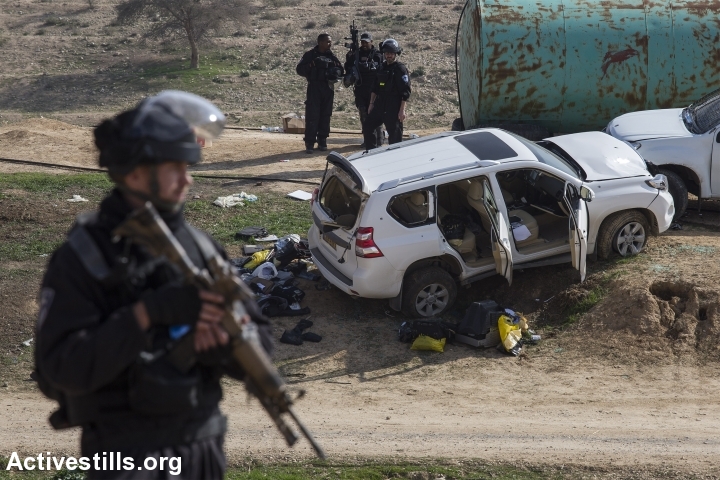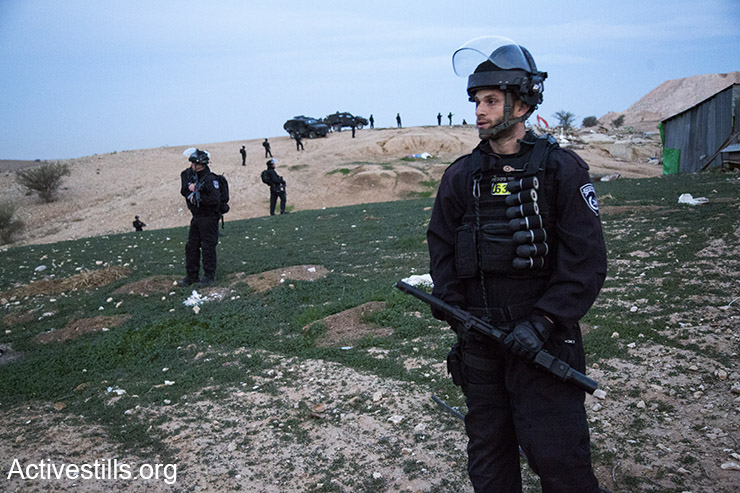Human rights group demands Israel Police reopen its case into the 2017 shooting of Joint List Chairman Ayman Odeh in the head with a sponge-tipped bullet after finding the initial investigation was ‘negligent.’

The Public Committee Against Torture in Israel is appealing Israel Police’s investigation of its officers’ conduct during a home demolition in the unrecognized Bedouin village of Umm al-Hiran in January 2017, and requesting that they reopen the case. The appeal is based on a new report by an expert criminologist who found that police did not interrogate all officers who were carrying sponge-tipped bullets on site, and failed to thoroughly review their own footage of MK Ayman Odeh’s shooting.
In its letter to the Police Internal Investigations Department, the committee claims that the previous investigation was “a blunder.” It writes that police deliberately targeted the Joint List chairman, and therefore his shooting should be investigated “as a serious criminal offense.”
The 50-page document is based on materials that the Police Internal Investigations Department itself had collected, in addition to other publicly available evidence that police failed to look at. In one video, for example, a green dot appears on Odeh’s forehead — likely a laser beam used when aiming firearms at a target — moments before officers fired at him with a sponge-tipped bullet.
Odeh suffered minor wounds in his head and back as a result. He filed a complaint with the Police Internal Investigations Department, accusing the police of aggravated assault and unlawful use of a weapon, but the case was closed in September 2018. According to the police report: “Even with the assumption that the object that hit [Odeh] was fired by police, it could not be determined who of the officers had done so.”
In March, through the Public Committee Against Torture in Israel, Odeh appealed the closing of the case. Last month, after the committee received additional evidence, it filed their detailed investigative report as a supplement to the appeal.
“There are so many materials that the [police] didn’t use or check their relevance to the investigation, this is a serious problem,” said Dr. Ariel Livneh, the criminology expert who reviewed the case for the Public Committee Against Torture. “It’s akin to overlooking fingerprints on a knife at a murder scene. It’s such a gaffe, which itself requires reopening the case.”
In response to a request for comment, the Police Internal Investigations Department said: “An appeal was made in this case and is currently being processed. A response will be provided to the petitioners when a decision is made regarding the appeal.”

In the early morning hours of Jan. 18, 2017, hundreds of police officers raided the unrecognized village of Umm al-Hiran in the Negev. During the raid, the officers shot and killed Yaqub Abu al-Qi’an, a Bedouin resident who had just started his car at the time. He subsequently careened into Israeli police officer Erez Levy, killing him. Moments after shooting Abu al-Qi’an, police fired tear gas, stun grenades and sponge-tipped bullets at Odeh and other activists who tried to get closer to the fatally-wounded resident.
Police immediately labeled the event as an ISIS-inspired “terror attack,” but the evidence contradicts this version of events. Days after the incident, Local Call and +972 Magazine published a preliminary investigation by the London-based Forensic Architecture research center, analyzing footage filmed by Activestills photographer Keren Manor and a police drone.
According to the investigation, Abu al-Qi’an lost control of his vehicle only after police shot him. Further claims made by the police, including that Abu al-Qi’ans headlights were off and that he accelerated as he hit the policemen, were also debunked.
A second Forensic Architecture report released in June included an investigation into Odeh’s shooting. The report by the Public Committee Against Torture coupled with Dr. Livneh’s assessment expose significant failures in Israel Police’s investigation of the case.
“It is reasonable to assume that police didn’t arbitrarily fire a sponge-tipped bullet at the crowd, but deliberately aimed at MK Ayman Odeh’s head,” says the Public Committee Against Torture report. They add that if aiming at Odeh’s head was indeed intentional, it could have ended with his murder, which “turns the case into one that requires a serious criminal investigation.”
“The way the investigation was handled and the closing of the case are proof that the police treats Arabs as enemies, not as citizens. This was no less than an assassination attempt. We will fight the systemic cover-up efforts by police for the Arab community and every citizen of the state,” said Odeh.
According to Dr. Livneh’s report, eight photographers — three with the police force, and five civilians — documented various parts of Odeh’s shooting. When Manor went to submit her video to police as evidence, in November 2017, they refused to accept it, claiming they had already seen similar footage. Manor said she was not asked to testify as to what she saw, heard and documented that night.
The police also ignored video evidence by activist Ya’ala Ra’nan, who filmed officers firing tear gas from close range at her, MK Odeh and others on her mobile phone. The video clearly shows the faces of the officers who were involved, as well as those standing nearby who could have fired the sponge-tipped bullet at Odeh seconds after. Ra’nan filed her video with police in February 2017, but Livneh could find no evidence in the police report that they actually watched the clip.
A 1:49-minute long video shot by an Al Jazeera reporter was also submitted to police. Based on police reports, the investigators stopped the video 20 seconds before it ends. By Dr. Livneh’s account, it is in those final seconds that Odeh is seen reacting to the hit by a sponge-tipped bullet.
In another police report from July 2017, investigators comment on two videos filmed by police, stating that most of the clips were filmed in dark conditions, and that they proceeded to analyze only the segments that included some lighting.
“Every child knows that, using a media player, one can increase the brightness and improve the visibility of a video, this is not something that requires exceptional resources,” said Dr. Livneh. “This conduct repeats itself. If I’m capable of increasing the visibility in these videos, so can police investigators,” he added.
Dr. Livneh concludes the report by saying he could not find an explanation for why the officers fired sponge-tipped bullets. He also could not find details regarding the firing incident or the shooters involved. According to police regulations, an officer who uses a firearm must fill out a report. Dr. Livneh could only find three such reports in the police investigation, by officers who were nowhere near Odeh’s shooting. In a separate incident, six residents and activists were hit by sponge-tipped bullets.
However, Dr. Livneh determines that police could still find the officer who shot Odeh. In another video, for example, two officers are seen within Odeh’s vicinity: one of whom was holding what looks like a firearm in a loading or unloading position, and another who was not interrogated by police. In the video that Manor filed, which police refused to examine, the same two officers, joined by another, are seen escaping the shooting scene. Dr. Livneh believes they could be the officers who shot Odeh, who then tried to escape quickly after wounding him.

In Dr. Livneh’s review of the police investigation, he found that there were no less than 10 officers carrying sponge-tipped bullets on site that day. Police had only brought three of those officers for questioning in Odeh’s case. He also writes that had Odeh and the activists been allowed to approach a fatally-wounded Abu al-Qi’an, he may have still been alive.
Dr. Livneh’s report implores police to check whether the decision to close the case “is compatible with the evidence handed to it,” and whether they have indeed run out of leads. He concludes by saying: “They are overlooking the materials that they themselves invested so much time and effort in collecting. It is unclear why they did not analyze all these materials. The conclusions I’ve arrived at are based on their own evidence. This is not a complicated case requiring special attention, all they have to do is read and watch the materials they themselves have gathered.”
Attorney Noa Levy, with the Public Committee Against Torture, said: “The Police Internal Investigations Department led a negligent investigation that is typical of it; it refrained from questioning the relevant officers, did not collect all available evidence, and did not analyze them as sufficiently as it could have.” She added: “We demand that police reopen the case and prosecute the officers responsible for the fatal shooting, for firing stun grenades and tear gas toward a governing member of parliament.”
A version of this article was first published in Hebrew on Local Call. Read it here.

